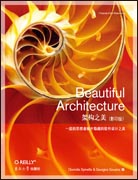
架构之美(影印版)
Diomidis Spinellis, Georgios Gousios 编
出版时间:2010年07月
页数:404
“本书作者完成了一项非常美妙的工程。这本书不仅涵盖了软件架构中的一些基本原理和最佳实践,它同时还涉及了广泛的当代系统。我特别享受于这些系统所触及的不同的架构,从Emacs到Facebook,从高度和谐的系统到更轻巧的系统。简而言之,这本书为软件架构的艺术性、科学性和实践性提供了非常及时和有益的贡献。”
——Grady Booch,IBM院士
健壮、优雅、灵活和易维护的软件架构是怎样炼成的?本书通过一系列优秀的文章回答了这个问题,这些文章来自于十几位当今一流的软件设计师和架构师。在每篇文章中,作者都向我们展示了一个著名的软件架构,并分析了什么让其具有创新性,让其符合设计目标。
本书内容包括:
· Facebook的架构如何建立在以数据为中心的应用生态系统之上
· Xen的创新架构对操作系统未来的影响
· KDE项目的社群过程如何让软件的架构从粗略的草图成为漂亮的系统
· 蔓延的特征如何让GNU Emacs获得意想不到的功能
· Jikes RVM自优化、自托管(self-hosting)的运行时环境背后的魔法
本书还获得了以下人员的帮助:
John Klein 和 David Weiss
Pete Goodliffe
Jim Waldo
Michael Nygard
Brian Sletten
Dave Fetterman
Derek Murray 和 Keir Fraser
Greg Lehey
Rhys Newman 和 Christopher Dennis
Ian Rogers 和 Dave Grove
Jim Blandy
Till Adam 和 Mirko Boehm
Bertrand Meyer
Panagiotis Louridas
——Grady Booch,IBM院士
健壮、优雅、灵活和易维护的软件架构是怎样炼成的?本书通过一系列优秀的文章回答了这个问题,这些文章来自于十几位当今一流的软件设计师和架构师。在每篇文章中,作者都向我们展示了一个著名的软件架构,并分析了什么让其具有创新性,让其符合设计目标。
本书内容包括:
· Facebook的架构如何建立在以数据为中心的应用生态系统之上
· Xen的创新架构对操作系统未来的影响
· KDE项目的社群过程如何让软件的架构从粗略的草图成为漂亮的系统
· 蔓延的特征如何让GNU Emacs获得意想不到的功能
· Jikes RVM自优化、自托管(self-hosting)的运行时环境背后的魔法
本书还获得了以下人员的帮助:
John Klein 和 David Weiss
Pete Goodliffe
Jim Waldo
Michael Nygard
Brian Sletten
Dave Fetterman
Derek Murray 和 Keir Fraser
Greg Lehey
Rhys Newman 和 Christopher Dennis
Ian Rogers 和 Dave Grove
Jim Blandy
Till Adam 和 Mirko Boehm
Bertrand Meyer
Panagiotis Louridas
- FOREWORD
- PREFACE
- Part One ON ARCHITECTURE
- 1 WHAT IS ARCHITECTURE?
- Introduction
- Creating a Software Architecture
- Architectural Structures
- Good Architectures
- Beautiful Architectures
- Acknowledgments
- References
- 2 A TALE OF TWO SYSTEMS: A MODERN-DAY SOFTWARE FABLE
- The Messy Metropolis
- Design Town
- So What?
- Your Turn
- References
- Part Two ENTERPRISE APPLICATION ARCHITECTURE
- 3 ARCHITECTING FOR SCALE
- Introduction
- Context
- The Architecture
- Thoughts on the Architecture
- 4 MAKING MEMORIES
- Capabilities and Constraints
- Workflow
- Architecture Facets
- User Response
- Conclusion
- References
- 5 RESOURCE-ORIENTED ARCHITECTURES: BEING “IN THE WEB”
- Introduction
- Conventional Web Services
- The Web
- Resource-Oriented Architectures
- Data-Driven Applications
- Applied Resource-Oriented Architecture
- Conclusion
- 6 DATA GROWS UP: THE ARCHITECTURE OF THE FACEBOOK PLATFORM
- Introduction
- Creating a Social Web Service
- Creating a Social Data Query Service
- Creating a Social Web Portal: FBML
- Supporting Functionality for the System
- Summation
- Part Three SYSTEMS ARCHITECTURE
- 7 XEN AND THE BEAUTY OF VIRTUALIZATION
- Introduction
- Xenoservers
- The Challenges of Virtualization
- Paravirtualization
- The Changing Shape of Xen
- Changing Hardware, Changing Xen
- Lessons Learned
- Further Reading
- 8 GUARDIAN: A FAULT-TOLERANT OPERATING SYSTEM ENVIRONMENT
- Tandem/16: Some Day All Computers Will Be Built Like This
- Hardware
- Mechanical Layout
- Processor Architecture
- The Interprocessor Bus
- Input/Output
- Process Structure
- Message System
- File System
- Folklore
- The Downside
- Posterity
- Further Reading
- 9 JPC: AN X86 PC EMULATOR IN PURE JAVA
- Introduction
- Proof of Concept
- The PC Architecture
- Java Performance Tips
- Four in Four: It Just Won’t Go
- The Perils of Protected Mode
- Fighting A Losing Battle
- Hijacking the JVM
- Ultimate Flexibility
- Ultimate Security
- It Feels Better the Second Time Around
- 10 THE STRENGTH OF METACIRCULAR VIRTUAL MACHINES: JIKES RVM
- Background
- Myths Surrounding Runtime Environments
- A Brief History of Jikes RVM
- Bootstrapping a Self-Hosting Runtime
- Runtime Components
- Lessons Learned
- References
- Part Four END-USER APPLICATION ARCHITECTURES
- 11 GNU EMACS: CREEPING FEATURISM IS A STRENGTH
- Emacs in Use
- Emacs’s Architecture
- Creeping Featurism
- Two Other Architectures
- 12 WHEN THE BAZAAR SETS OUT TO BUILD CATHEDRALS
- Introduction
- History and Structure of the KDE Project
- Akonadi
- ThreadWeaver
- Part Five LANGUAGES AND ARCHITECTURE
- 13 SOFTWARE ARCHITECTURE: OBJECT-ORIENTED VERSUS FUNCTIONAL
- Overview
- The Examples
- Assessing the Modularity of Functional Solutions
- An Object-Oriented View
- Assessing and Improving OO Modularity
- Agents: Wrapping Operations into Objects
- References
- 14 REREADING THE CLASSICS
- Everything Is an Object
- Types Are Defined Implicitly
- Problems
- Brick and Mortar Architecture
- References
- AFTERWORD
- CONTRIBUTORS
- INDEX
书名:架构之美(影印版)
作者:Diomidis Spinellis, Georgios Gousios 编
国内出版社:东南大学出版社
出版时间:2010年07月
页数:404
书号:978-7-5641-2273-7
原版书出版商:O'Reilly Media
The animal on the cover of FILL IN TITLE is FILL IN DESCRIPTION.
The cover image is FILL IN CREDITS.
The cover image is FILL IN CREDITS.
购买选项